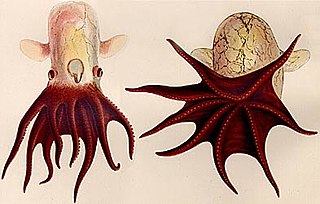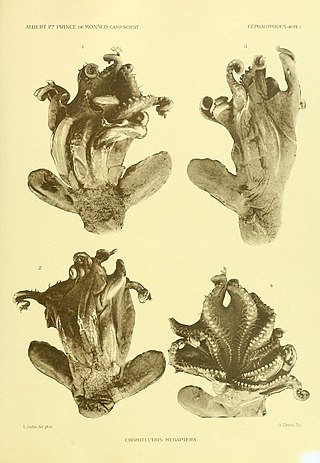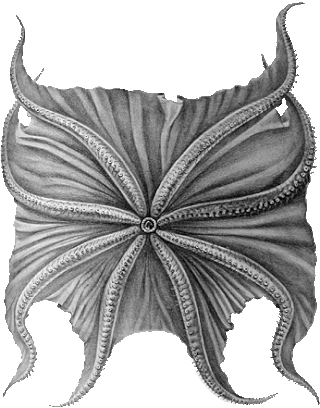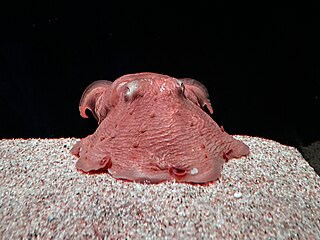
Grimpoteuthis is a genus of pelagic cirrate (finned) octopods known as the dumbo octopuses. The name "dumbo" originates from their resemblance to the title character of Disney's 1941 film Dumbo, having two prominent ear-like fins which extend from the mantle above each eye. There are 17 species recognized in the genus. Prey include crustaceans, bivalves, worms and copepods. The average life span of various Grimpoteuthis species is 3–5 years.

The paintpot cuttlefish is a small, poorly researched species of cuttlefish found in the Indo-Pacific, between Japan and Hong Kong. It is one of the two species classified in the genus Metasepia. Metasepia cuttlefish are characterized by their small, thick, diamond-shaped cuttlebone, and distinctive body coloration.
Grimpoteuthis abyssicola, commonly known as the red jellyhead, is a species of small deep-sea octopus known from two specimens. The holotype specimen was a female collected on the Lord Howe Rise, between 3154 and 3180 meters depth. A second specimen was collected on the continental slope of south-eastern Australia between 2821 and 2687 m depth.
Grimpoteuthis boylei is a species of octopus known from only ten individuals.
Grimpoteuthis challengeri is a species of large octopus living in the abyssal zone.

Grimpoteuthis discoveryi is a small species of octopus known from more than 50 specimens. It was described in 2003, but specimens have been found as early as 1910. The type species was found at 49°35'N, 14°01'W.

Grimpoteuthis hippocrepium is a species of octopus. It is only known from one specimen found in 1904, which was poorly preserved. Some characteristics G. hippocrepium are unknown.
Grimpoteuthis innominata, commonly known as the small jellyhead, is a species of small, pelagic octopus described by Steve O'Shea in 1999 from two specimens, however several further specimens have since been identified. The genus Enigmateuthis was described to contain this species when described, but Martin Collins placed the species in the genus Grimpoteuthis due to uncertainty regarding the type specimen of Grimpoteuthis.

Grimpoteuthis megaptera is a species of octopus known from five specimens, collected by Addison Emery Verrill. Between two and three of these specimens may belong to different species.

Grimpoteuthis pacifica is an octopus known from one badly damaged specimen. It is not completely described, and it is not easily separated from some other species of octopus. Nothing clearly differentiates G. pacifica from Grimpoteuthis hippocrepium except for its type locality.

Grimpoteuthis plena is known from only one specimen, which cannot be easily separated from other species of Grimpoteuthis in the Atlantic Ocean. The specimen was in poor condition. It's similar to Grimpoteuthis wuelkeri, and may be a junior specimen of Grimpoteuthis umbellata.
Grimpoteuthis tuftsi is an octopus known from seven specimens.

Grimpoteuthis umbellata, known from three specimens, is the type species of Grimpoteuthis.
Grimpoteuthis wuelkeri is a medium-sized octopus characterized from multiple specimens.
Opisthoteuthis calypso or calypso flapjack octopus is a species of genus Opisthoteuthis, which are known as the cirrate octopuses. Octopuses in this genus are known as the flapjack octopuses and can be found in a variety of oceans across the world.

Opisthoteuthis agassizii is a lesser-known, deep-sea octopus first described in 1883 by Addison E. Verrill.
Opisthoteuthis bruuni is a species of finned cirrate octopus found along the western coast of South America. Their tissue is almost jelly-like, and they have short, round bodies.

Opisthoteuthis depressa, also known as the Japanese flapjack octopus, is an octopus found in waters near Japan.
Opisthoteuthis dongshaensis is a species of octopus located in the South China Sea.
Opisthoteuthis massyae is an octopus living in the eastern Atlantic Ocean.











